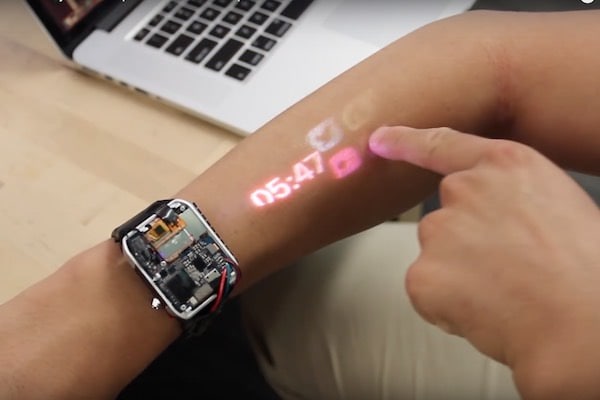
[Image above] A new smartwatch prototype called LumiWatch has a built-in projector that transforms your skin into a touchscreen. Credit: Robert Xiao; YouTube
Touchscreen smartwatches are great—in theory.
The devices offer most of the same abilities as your smartphone, albeit nestled into a smaller device that you snuggly attach to your wrist—right where it’s easy to access.
But a big challenge in designing a really functional smartwatch is balancing form and function—you don’t want a big, bulky device strapped to your wrist, but you also want a touchscreen that’s big enough to actually be functional.
Researchers and engineers at Carnegie Mellon University (Pittsburgh, Pa.) and ASU Tech Co. Ltd. (Beijing, China) have a solution that thinks outside the box—a smartwatch that has a built-in projector that instead turns your skin into the touchscreen.
Their prototype device, called LumiWatch, projects a touchscreen onto the wearer’s own skin to expand its functional area to ~40 cm2—more than five times the interactive surface area of a typical smartwatch display, the scientists report.
LumiWatch consists of five primary components:
- Logic board – 1.2GHz quad-cored CPU running Android 5.1
- Projector – 15 lumen pico laser projector that projects a 1024×600 pixel image
- Depth-sensing array – 1D depth sensing array with 10 time-of-flight sensors
- Metal enclosure – 50-mm aluminum case—just slightly bigger than a 42-mm Apple Watch
- Battery – 740mAh, 3.8 V (2.8Wh) lithium-ion battery that offers 1 hour of continuous use or an estimated 1 day of intermittent use
Watch this. (Yep, pun totally intended.)

Credit: Robert Xiao; YouTube
As cool as it is, however, unfortunately you won’t be strapping the LumiWatch to your own wrist anytime soon. The prototype needs a lot of tweaking before it can move towards commercial production. Read more about LumiWatch here.
But the scientists report that the prototype is built from just $600 of custom hardware—offering promise that the concept can be tweaked and adjusted enough to make such technology actually feasible in the near future.
Keep watching…
Author
April Gocha
CTT Categories
- Electronics
- Material Innovations
- Optics


